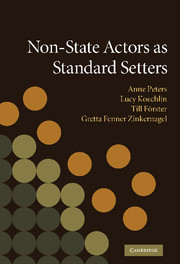Book contents
- Frontmatter
- Contents
- List of figures
- List of tables
- List of contributors
- Acknowledgements
- List of abbreviations
- Preface
- 1 Non-state actors as standard setters: framing the issue in an interdisciplinary fashion
- PART I New actors and processes in contemporary standard setting
- PART II The legitimacy and accountability of actors and standards
- PART III The authority and effectiveness of actors and standards
- 13 Standard setting for capital movements: reasserting sovereignty over transnational actors?
- 14 Certification as a new private global forest governance system: the regulatory potential of the Forest Stewardship Council
- 15 Private standards in the North – effective norms for the South?
- 16 International corporate social responsibility standards: imposing or imitating business responsibility in Lithuania?
- 17 Legal pluralism under the influence of globalisation: a case study of child adoption in Tanzania
- 18 Towards non-state actors as effective, legitimate, and accountable standard setters
- Index
- References
14 - Certification as a new private global forest governance system: the regulatory potential of the Forest Stewardship Council
from PART III - The authority and effectiveness of actors and standards
Published online by Cambridge University Press: 06 January 2010
- Frontmatter
- Contents
- List of figures
- List of tables
- List of contributors
- Acknowledgements
- List of abbreviations
- Preface
- 1 Non-state actors as standard setters: framing the issue in an interdisciplinary fashion
- PART I New actors and processes in contemporary standard setting
- PART II The legitimacy and accountability of actors and standards
- PART III The authority and effectiveness of actors and standards
- 13 Standard setting for capital movements: reasserting sovereignty over transnational actors?
- 14 Certification as a new private global forest governance system: the regulatory potential of the Forest Stewardship Council
- 15 Private standards in the North – effective norms for the South?
- 16 International corporate social responsibility standards: imposing or imitating business responsibility in Lithuania?
- 17 Legal pluralism under the influence of globalisation: a case study of child adoption in Tanzania
- 18 Towards non-state actors as effective, legitimate, and accountable standard setters
- Index
- References
Summary
The failure of intergovernmental negotiation processes on forests
As ‘global public goods’ that benefit numerous states and cannot be controlled by any one, forests present a particular challenge to national regulators. In response, governments began in the early 1980s to negotiate on forest regulation. These intergovernmental coordination efforts aimed to create binding and hierarchical measures for implementing international policies at the national level and produced forest management and protection standards. They therefore resulted in the creation of a ‘regime’, that is, ‘a set of principles, standards, rules and decision-making procedures, whether explicit or implicit, around which actors’ expectations converge in a specific area of international relations'. However, from the beginning, it was a regime weakened by fragmentation.
A fragmented international architecture
The architecture of international forest regulation is complex and segmented, due to the overlapping responsibilities for forest issues among different institutions and instruments. The forest negotiation process at the 1992 Rio Earth Summit resulted in non-binding texts, including the Forest Declaration and Chapter 11 of Agenda 21, and continues today under the auspices of the United Nations Forum on Forests (UNFF). Two other multilateral instruments are specifically devoted to forests: the International Tropical Timber Agreement (ITTA) and the FAO Committee on Forestry. Other non-specific international mechanisms incorporate provisions that are essential for forests. In particular, the Kyoto Protocol to the United Nations Framework Convention on Climate Change (UNFCCC) regards forests as carbon sinks and the prevention of deforestation as a means of combating carbon emissions.
Information
- Type
- Chapter
- Information
- Non-State Actors as Standard Setters , pp. 379 - 408Publisher: Cambridge University PressPrint publication year: 2009
References
Accessibility standard: Unknown
- 5
- Cited by
